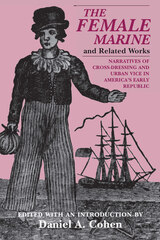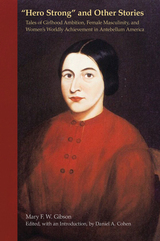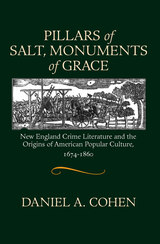3 books about Cohen, Daniel A.

"The Female Marine" and Related Works
Narratives of Cross-Dressing and Urban Vice in America's Early Republic
Daniel A. Cohen
University of Massachusetts Press, 1998
This is the first complete modern edition of The Female Marine, a fictional cross-dressing trilogy originally published between 1815 and 1818. Enormously popular among New England readers, the tale in various versions appeared in no fewer than nineteen editions over that brief four-year span. This new edition appends three other contemporary accounts of cross-dressing and urban vice which, together with The Female Marine, provide a unique portrayal of prostitution and interracial city life in early-nineteenth-century America.
The alternately racy and moralistic narrative recounts the adventures of a young woman from rural Massachusetts who is seduced by a false-hearted lover, flees to Boston, and is entrapped in a brothel. She eventually escapes by disguising herself as a man and serves with distinction on board the U.S. frigate Constitution during the War of 1812. After subsequent onshore adventures in and out of male dress, she is happily married to a wealthy New York gentleman.
In his introduction, Daniel A. Cohen situates the story in both its literary and historical contexts. He explains how the tale draws upon a number of popular Anglo-American literary genres, including the female warrior narrative, the sentimental novel, and the urban exposé. He then explores how The Female Marine reflects early-nineteenth-century anxieties concerning changing gender norms, the expansion of urban prostitution, the growth of Boston's African American community, and feelings of guilt aroused by New England's notoriously unpatriotic activities during the War of 1812.
The alternately racy and moralistic narrative recounts the adventures of a young woman from rural Massachusetts who is seduced by a false-hearted lover, flees to Boston, and is entrapped in a brothel. She eventually escapes by disguising herself as a man and serves with distinction on board the U.S. frigate Constitution during the War of 1812. After subsequent onshore adventures in and out of male dress, she is happily married to a wealthy New York gentleman.
In his introduction, Daniel A. Cohen situates the story in both its literary and historical contexts. He explains how the tale draws upon a number of popular Anglo-American literary genres, including the female warrior narrative, the sentimental novel, and the urban exposé. He then explores how The Female Marine reflects early-nineteenth-century anxieties concerning changing gender norms, the expansion of urban prostitution, the growth of Boston's African American community, and feelings of guilt aroused by New England's notoriously unpatriotic activities during the War of 1812.
[more]

“Hero Strong” and Other Stories
Tales of Girlhood Ambition, Female Masculinity, and Women’s Worldly Achievement in Antebellum America
Mary F.W. Gibson
University of Tennessee Press, 2014
A teenage orphan from Vermont, Mary Gibson burst onto the literary scene during the
early 1850s as a star writer, under the pseudonym Winnie Woodfern, for more than half a
dozen Boston “story papers,” mass-circulation weekly periodicals that specialized in popular
fiction. Although she would soon join such famous woman authors as Fanny Fern
and E. D. E. N. Southworth as featured contributors to the New York Ledger, America’s
greatest story paper, Gibson’s subsequent output rarely matched the gender-bending creativity
of the tales written in her late teens and early twenties and reprinted in this volume.
But “Hero Strong” and Other Stories does much more than recover the work of a
forgotten literary prodigy. As explained by historian Daniel A. Cohen, Gibson’s tales
also illuminate major interrelated transformations in American girlhood and American
women’s authorship. Challenging traditional gender expectations, thousands of girls of
Gibson’s generation not only aspired to public careers as writers, artists, educators, and
even doctors but also began to experiment with new forms of “female masculinity” in
attitude, bearing, behavior, dress, and sexuality—a pattern only gradually domesticated
by the nonthreatening image of the “tomboy.” Some, such as Gibson, at once realized and
reenacted their dreams on the pages of antebellum story papers.
This first modern scholarly edition of Mary Gibson’s early fiction features ten tales of
teenage girls (seemingly much like Gibson herself) who fearlessly appropriate masculine
traits, defy contemporary gender norms, and struggle to fulfill high worldly ambitions.
In addition to several heroines who seek “fame and riches” as authors or artists,
Gibson’s unconventional protagonists include three female medical students who resort to
grave robbing and a Boston ingénue who dreams of achieving military glory in battle. By
moving beyond “literary domesticity” and embracing bold new models of women’s
authorship, artistry, and worldly achievement, Gibson and her fictional protagonists stand
as exemplars of “the first generation of American girls who imagined they could do almost
anything.”
Daniel A. Cohen is an associate professor of history at Case Western Reserve University.
His previous publications include Pillars of Salt, Monuments of Grace: New England Crime
Literature and the Origins of American Popular Culture, 1674–1860 and ‘The Female Marine’
and Related Works: Narratives of Cross-Dressing and Urban Vice in America’s Early
Republic.
early 1850s as a star writer, under the pseudonym Winnie Woodfern, for more than half a
dozen Boston “story papers,” mass-circulation weekly periodicals that specialized in popular
fiction. Although she would soon join such famous woman authors as Fanny Fern
and E. D. E. N. Southworth as featured contributors to the New York Ledger, America’s
greatest story paper, Gibson’s subsequent output rarely matched the gender-bending creativity
of the tales written in her late teens and early twenties and reprinted in this volume.
But “Hero Strong” and Other Stories does much more than recover the work of a
forgotten literary prodigy. As explained by historian Daniel A. Cohen, Gibson’s tales
also illuminate major interrelated transformations in American girlhood and American
women’s authorship. Challenging traditional gender expectations, thousands of girls of
Gibson’s generation not only aspired to public careers as writers, artists, educators, and
even doctors but also began to experiment with new forms of “female masculinity” in
attitude, bearing, behavior, dress, and sexuality—a pattern only gradually domesticated
by the nonthreatening image of the “tomboy.” Some, such as Gibson, at once realized and
reenacted their dreams on the pages of antebellum story papers.
This first modern scholarly edition of Mary Gibson’s early fiction features ten tales of
teenage girls (seemingly much like Gibson herself) who fearlessly appropriate masculine
traits, defy contemporary gender norms, and struggle to fulfill high worldly ambitions.
In addition to several heroines who seek “fame and riches” as authors or artists,
Gibson’s unconventional protagonists include three female medical students who resort to
grave robbing and a Boston ingénue who dreams of achieving military glory in battle. By
moving beyond “literary domesticity” and embracing bold new models of women’s
authorship, artistry, and worldly achievement, Gibson and her fictional protagonists stand
as exemplars of “the first generation of American girls who imagined they could do almost
anything.”
Daniel A. Cohen is an associate professor of history at Case Western Reserve University.
His previous publications include Pillars of Salt, Monuments of Grace: New England Crime
Literature and the Origins of American Popular Culture, 1674–1860 and ‘The Female Marine’
and Related Works: Narratives of Cross-Dressing and Urban Vice in America’s Early
Republic.
[more]

Pillars of Salt, Monuments of Grace
New England Crime Literature and the Origins of American Popular Culture, 1674-1860
Daniel A. Cohen
University of Massachusetts Press, 2006
In this innovative study, Daniel A. Cohen explores a major cultural shift embodied in hundreds of early New England crime publications. Tracing the declining authority of Puritan ministers, he shows how the arbiters of an increasingly pluralistic literary marketplace gradually supplanted pious execution sermons with last-speech broadsides, gallows verses, criminal autobiographies, trial reports, newspaper stories, and romantic docudramas. Pillars of Salt, Monuments of Grace probes the forgotten origins of our modern mass media's preoccupation with crime and punishment.
[more]
READERS
Browse our collection.
PUBLISHERS
See BiblioVault's publisher services.
STUDENT SERVICES
Files for college accessibility offices.
UChicago Accessibility Resources
home | accessibility | search | about | contact us
BiblioVault ® 2001 - 2024
The University of Chicago Press









